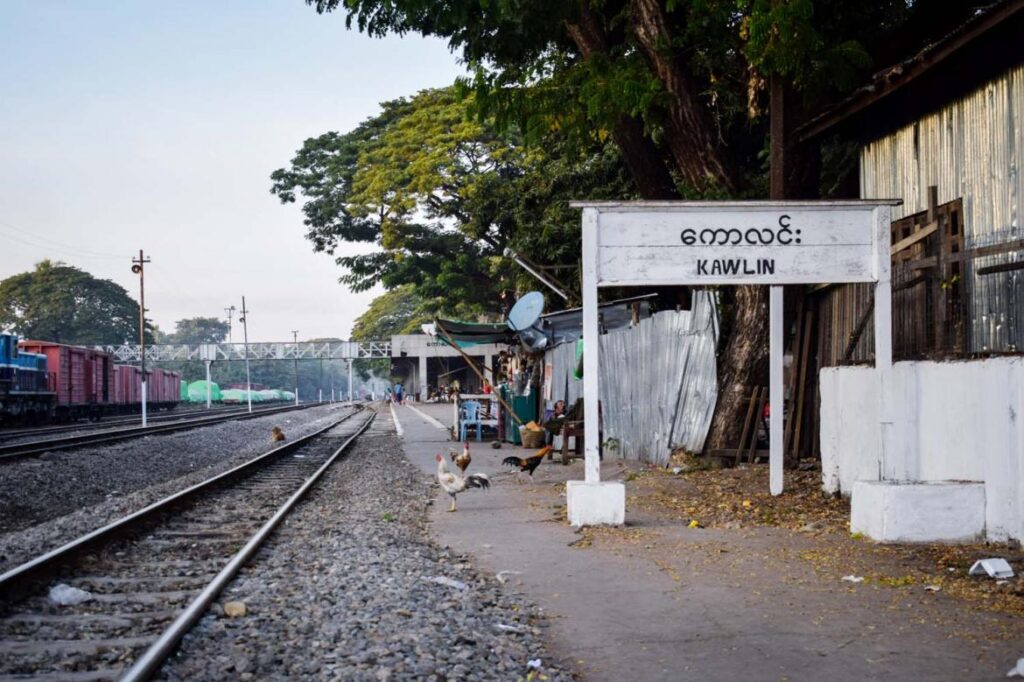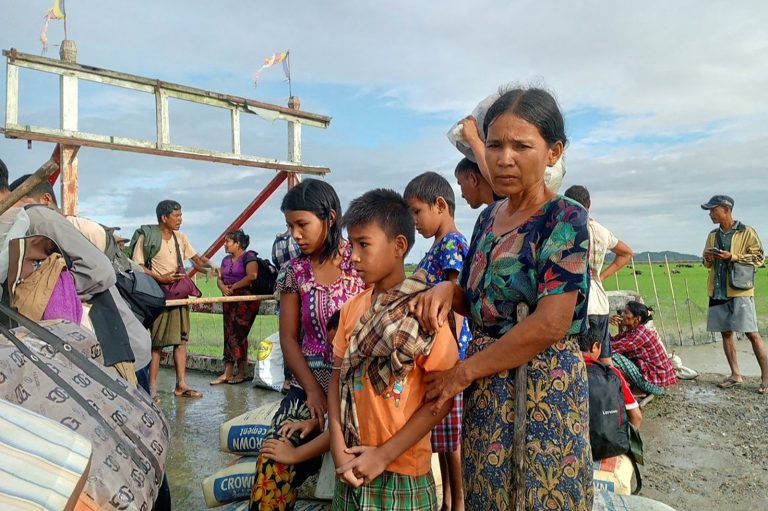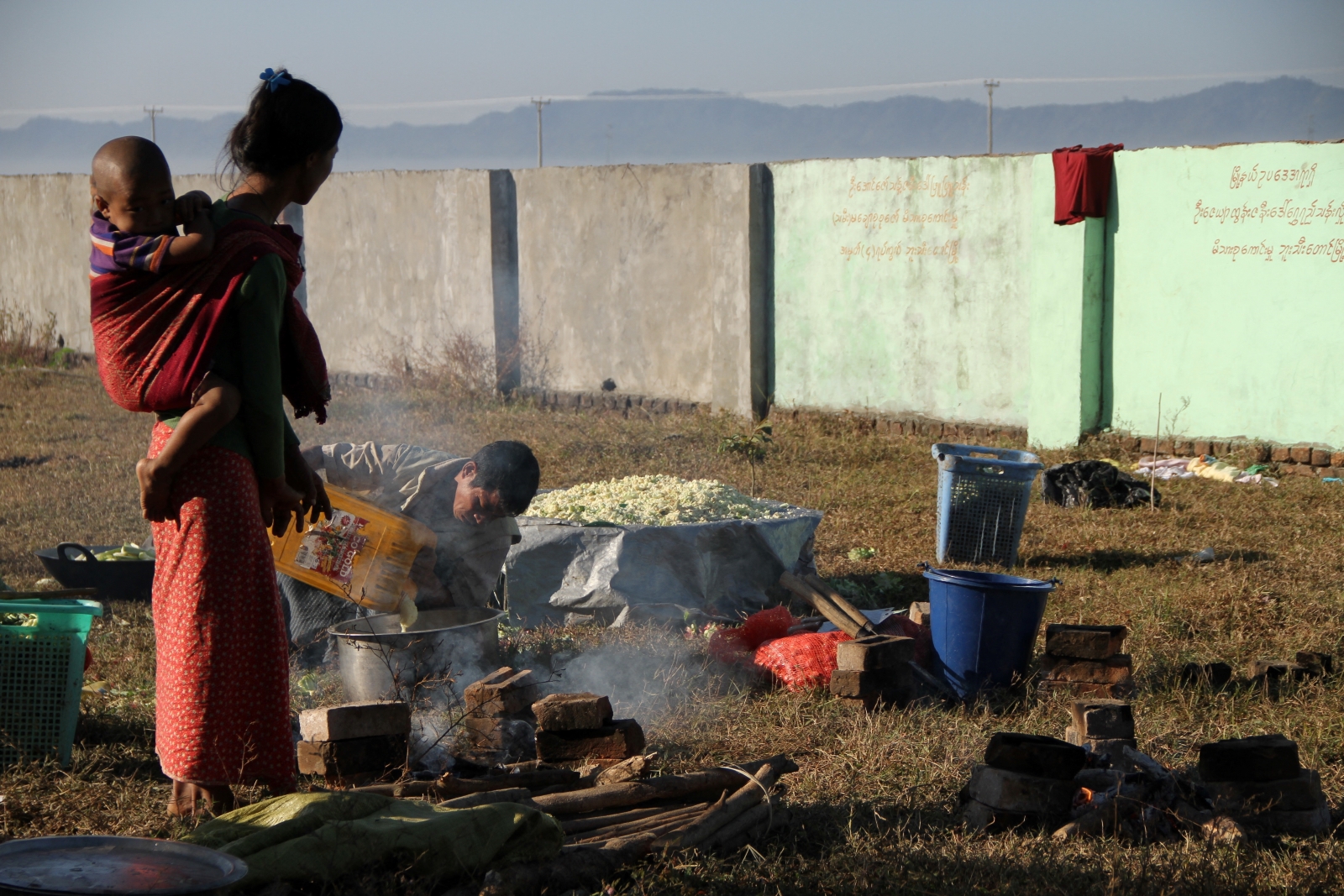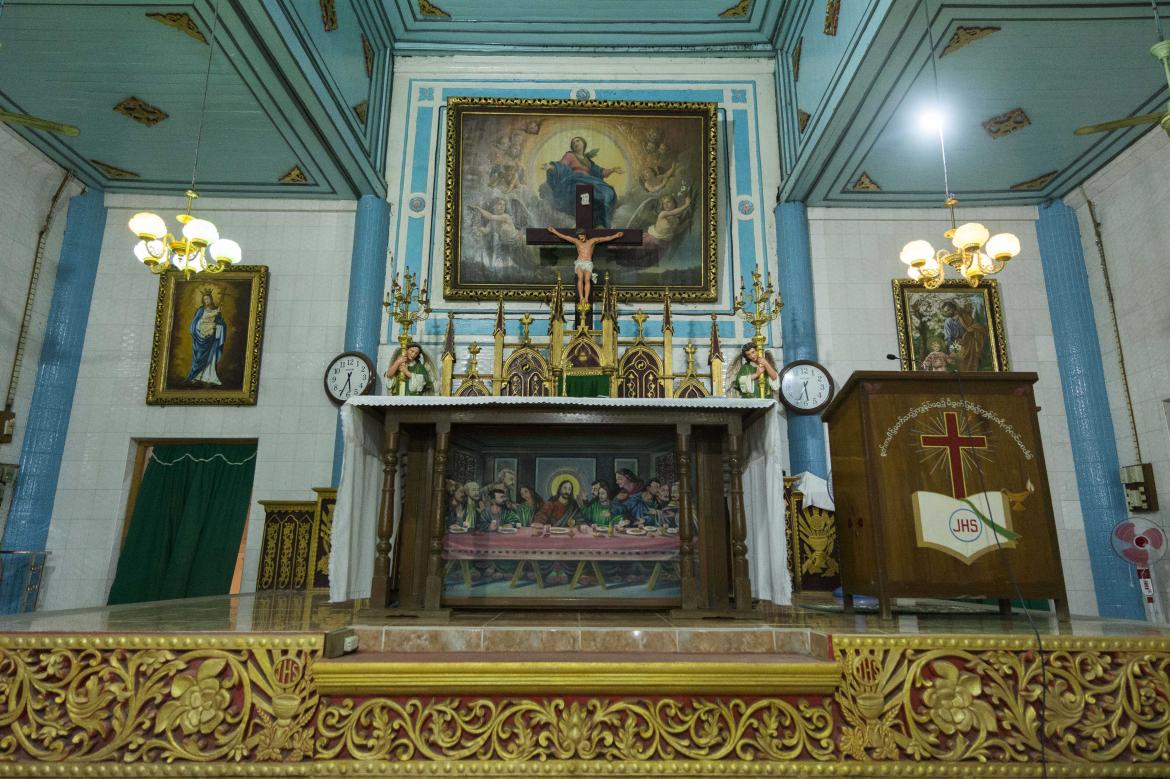The People’s Defence Force has suffered a major symbolic setback by losing control of the first town it seized – accusing the Myanmar military of destroying Kawlin in order to reclaim it – but its troops vow to fight on.
By FRONTIER
Resistance groups told Ma Thida* to flee Kawlin by February 1 as the military closed in on the Sagaing Region town. She packed only a small bag, thinking the People’s Defence Force and Kachin Independence Army would be able to repel the attack, but she hasn’t been able to return since.
Her home and rice warehouse were burned down in the ensuing battle, leaving her destitute and hopeless.
“Over 1,000 baskets of rice were lost in the fire, including those we grew in our own field and those we purchased from other farmers,” she said. “It’s a bitter loss.”
On November 6, Kawlin became the first town to be claimed by the PDF, a loose-knit force built from armed groups that rose up spontaneously to fight the military regime. The PDF is largely loyal to the National Unity Government, a cabinet appointed by elected lawmakers deposed in the 2021 military coup, and often cooperates with more established ethnic armed groups like the KIA, which has been fighting for autonomy for decades.
Ma Thida and her six family members fled Min Tae Gyi ward, joining the 28,000 internally displaced people across Kawlin Township. They’re living in a makeshift hut on a relative’s property in Khamauk Taung village, where they said they’ve received little outside support.
“We’ve only received one pyi [a little more than 2 kilograms] of rice from the NUG. I’m not sure about the support received by IDPs in other places, since everyone scattered to find places to stay,” she said.
Daw Soe Soe*, who was displaced from Aung Thiri ward in Kawlin town to Kyauk Pyin Thar village, said she’s received no support at all yet. Her home and grocery shop, which cost around K30 million to build in 2012 (then worth around US$35,000), were also burned down in the fighting.
“My husband is suffering from depression and has become ill,” she said, explaining that his high blood pressure has been exacerbated by the recent physical and mental stress.
U Kyaw Zaw, spokesperson for the NUG president’s office, said that NUG departments are “providing assistance to IDPs from Kawlin town to the best of their ability”. But U Maung Maung Swe, a spokesman for the NUG’s defence ministry, admitted that they are overstretched by both the humanitarian and battlefield needs.
The renewed humanitarian crisis is a harsh comedown from the heady optimism when the PDF-KIA alliance first took control of the town and encouraged displaced residents to return home. Many believed it showed the tide was turning against the junta and that the PDF was evolving beyond guerrilla warfare.
But now, the PDF finds itself back in a familiar position – harrying a better-equipped military from the rural fringes – while residents again flee to safer areas.
One resident, who worked as a security guard at Kawlin’s central market, said he paid more than half his monthly salary on March 2 to get to Mandalay, 300 kilometres to the south. The country’s second largest city, Mandalay remains firmly under the junta’s control and has seen little conflict besides sporadic bombings and assassinations by resistance groups.
“It cost me K80,000 to get here,” he said, a sum equivalent to $22 at the current market rate, explaining that a bus from Kawlin to Mandalay used to cost around K30,000. “These days, there are almost no regular buses and locals have to arrange their own transport… we have to pay whatever price the drivers ask, because they’re also taking a risk.”
King of the ashes
Fighting escalated across Myanmar in late October last year, when the Three Brotherhood Alliance of ethnic armed groups launched a major offensive, known as Operation 1027, going on to seize huge swathes of territory in northern Shan, southern Chin and Rakhine states.
Sensing the military was weak, other resistance groups launched similar offensives, with more towns falling in Chin and Kayah states and Sagaing Region. While the Brotherhood trio has kept some distance from the broader pro-democracy uprising, alliance member the Arakan Army reportedly assisted the PDF and KIA in seizing Kawlin, a district capital.
Soon afterwards, a fighter with the Kawlin PDF told Frontier he was worried taking the town could make it a target – and his fears were well-founded. Three months later, in mid-February, the resistance coalition was forced to retreat in the face of aerial bombardments and a major ground offensive.
“They sent thousands of troops and took control of the town by using excessive force including airstrikes and artillery,” said Maung Maung Swe. He said the PDF fighters evacuated Kawlin to minimise harm to civilians and property “in accordance with the people’s war strategy”, and killed many regime troops while retreating.

Kyaw Zaw said this concern for people’s welfare puts resistance groups at an inherent disadvantage, because the military intentionally harms civilians and destroys their homes as a form of collective punishment.
Despite marking the reversal of a major symbolic victory, he said the retreat from Kawlin is “like taking one step backwards in order to take two steps forward”.
Ko Awzar, leader of the Sagaing Region People’s Defence Team, which supervises a network of local anti-junta defence forces, said the military has essentially destroyed Kawlin in order to reclaim it, but is now blockaded among the ruins.
“They used their usual methods of burning, looting and destroying everything in the town, but we’ve surrounded and blockaded them,” he said. “Now we’re focused on reducing the enemy’s forces, while they’re focused on controlling the town, so our goals are not the same.”
Fighting continues in the nearby villages, and Maung Maung Swe said resistance forces will shift between offensive and defensive operations as required. He also said morale is higher among PDF fighters than the military’s beleaguered troops, and predicted Kawlin would fall again.
“We will retake the town in the long term,” he pledged. “Although the military council is in the town now, our troops still surround it.”
Liberated no more
Residents lament the military’s reconquest of Kawlin, saying life had improved under resistance rule.
“Life was more agreeable and free,” said Ma Thida, explaining that they weren’t subjected to arbitrary interrogations or intimidation like under the military. “The resistance forces didn’t abuse the people and they took care of the town’s security, patrolling the market frequently.”
But although she came into town regularly to go to the market, she didn’t stay there at night because regime troops in nearby Wuntho town sometimes shelled residential areas.
Another woman, from Kayak Pain Thar village on the outskirts of Kawlin town, said most people live in constant terror of the military. “But when we had to go to Kawlin town to buy things, we were never afraid when we encountered the PDF fighters,” she said.
The NUG formed an emergency management team after seizing the town to resume basic public services, and it encouraged displaced civilians and civil servants to return.
“We prioritised helping displaced people return and stay in the town in peace. We also maintained infrastructure and municipal services like water and electricity as much as we could, so that residents could run their businesses again,” said Kyaw Zaw.
Residents confirmed that the supply of water and electricity continued during that time, but said phone lines and internet connections were down. However, residents also said the emergency body was far from a standard administration.
“I didn’t notice anything particular about the NUG’s administration,” said a resident of Min Tae Gyi ward. “Maybe I didn’t notice because they governed for just a short period. But the PDF fighters protected the people the best they could while the town was under their control.”
While resistance leaders say they’ll win back the town eventually, Kawlin residents are left in limbo.
“I know my home isn’t even there anymore, but I still want to go back to my hometown as soon as I can, even if I have to live in a hut,” said Ma Thida from Min Tae Gyi ward.
Ma Thin Shwe, a woman in her 30s from Aung Thiri ward, said she also lost her house in a fire but is determined to keep her hopes up.
“I’m trying not to be too depressed, because I know I’m not the only one. But I’ll have to start from the bottom again while facing so many difficulties,” she said. “I’m also trying to lift up my parents’ spirits. The main thing we hope for is that the PDF will win soon so we can go back to our town.”
*indicates the use of a pseudonym for security reasons







